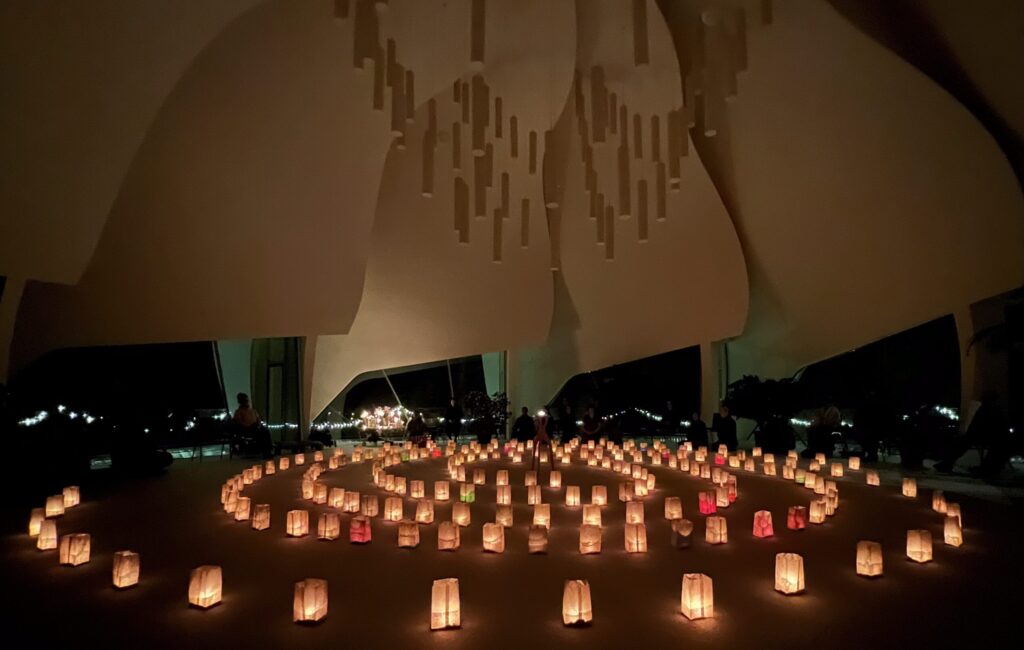
“If we can experience the world as Light and vibration, can we then accept all paths and religions as unique expressions of that oneness? If we first understand ourselves – our inner world and the impact of our own thoughts and choices on the world – can we then create the kind of world we would like to live in: a world of peace and harmony, a world based on personal responsibility, understanding and compassion?” – Swami Lalitananda (Light and Vibration) –
I am reflecting on Swami Lalitananda’s questions, when peace seems out of reach in Gaza and Ukraine, Syria and Sudan, and Iran has recently been under attack. Floods, fire and drought reduce areas of habitable and cultivatable land, driving people from their homes, adding to migration and displacement, and increasing the pressures that lead to conflicts. Meanwhile, global news floods our minds with daily reports of conflict, at a time when political propaganda is making thoughtful, compassionate dialogue increasingly difficult.
Against this backdrop, how can we cultivate words and thoughts that bring harmony and peace?
Of course, there have always been wars; and throughout the ages, even today – with or without war – for so many millions of people, life is a ceaseless struggle for survival. And yet, the search for inner peace has simultaneously been a worldwide constant theme of religions and spiritual quests.
The Bhagavad Gita addresses this human dilemma directly. It is a small poetic book embedded in the Mahabharata, a large Indian epic of dynastic struggles, whose stories tell of failed attempts at peace that lead to war.
The Gita begins as two vast armies stand mustered and ready for battle. At this pivotal point, Arjuna, hero and accomplished warrior, asks himself – Would it not be better to surrender everything and retire in peace? He does not know how he could continue to live with himself if he goes into battle against his own family and esteemed tutor. He throws down his bow in despair.
We learn that the true battle is within Arjuna’s soul and we are invited to reflect on the inner conflicts we face in our own lives. The battlefield falls silent. And in Discourses between Arjuna and Krishna that follow we are introduced to aspects of yoga and the ways these can help us – but not through inaction or by fleeing the field.
Called to a warrior’s life symbolically, we learn that inner peace is not found through avoidance of the distressing aspects of life. We find it through awareness, getting to understand our desires, fears, worries and motivations, tackling our inner conflicts and acting on our higher values and ideals. Through yogic practices, we engage with devotion and compassion and can expand our minds – wide, like the sky – learning to make the wisest choices available to us in our own unique circumstances.
I am very blessed to live at Yasodhara Ashram. Its beautiful location allows me to step back from many of the world’s pressures, yet not withdraw from the world. The Saraswati lineage of Yasodhara Ashram is about learning and teaching, knowledge and the arts.
In Swami Sivananda’s words, we are here to “Serve, love, give, purify, meditate, realise; Be good, do good, be kind, be compassionate.”
For me, this is about seeking to be a channel for Light in the world – whether through teaching. or chanting healing mantras to support world peace and end poverty, or working together to respond creatively to the threat of forest fires, health scares or a legacy of racial discrimination.
Giving back to the world in all its magic and complexity, as best I can, gives me experiences from which I can learn and grow.
In Kundalini Yoga for the West, Swami Radha asks, “Why must we spend time looking at the ugly side of life when the goal is just the opposite?” She answers, “there would be no appreciation for the bright sun if the night were not accepted also.” She advises against, “turning away and pretending the ugliness does not exist”, advocating instead working now “to make the Earth a place of peace and harmony.”
The goddess, Rakini, in the Second Cakra, holds a battle-axe representing our ability to tackle the “battle of life.” “Instincts, mechanical reactions, impulses, false pride, false modesty, selfishness, self-importance, self-pity – the aspirant has to fight and balance all these … with positive characteristics. Life can then take on greater quality – depth, peace, joy and harmony.” Meanwhile, our breath and mantra practices help until, “Finally, … joy and peace flood over the aspirant … gentle feelings of devotion and surrender.”
Swami Radha’s vision of our potential for peace is subtle and elusive. I find its gems can be easily missed until I am ready. Increasingly, I appreciate Swami Radha’s explanation of the symbol of the elephant, Airavata, in the fifth Cakra, with its promise of a “constant, gentle, steady peace of mind.” My life has become steadier, simpler and more clearly connected to my choices to control my mind.
During the pandemic, I began to offer an eleven-month online program – Peace of Mind for Professionals for those seeking inner peace in the midst of busy working lives. Drawing on the Yoga Sutras, the wisdom of Swamis Sivananda, Radha and Radhananda, and modern Buddhist writers on the world of work, the next series begins in September and I am reflecting on my experience of getting to know so many sincere, dedicated students. It is both precious and humbling to witness their commitment, progress, thinking and following through in so many positive ways.
A pause, just a few moments of calm – creating a space between action and reaction – allows us to connect with a quiet place of inner peace. A reflective Arjuna moment also helps to connect us with inner wisdom, to understand how best to support others who are also doing what they can in this challenging world.
By Swami Sukhananda
